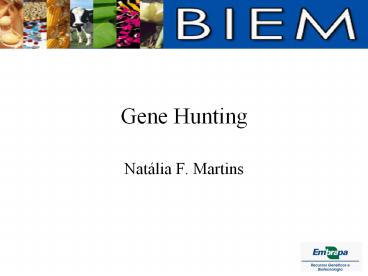Gene Hunting - PowerPoint PPT Presentation
1 / 25
Title: Gene Hunting
1
Gene Hunting
- Natália F. Martins
2
Resumo
- Motivação
- Estratégia
- Automatização (?)
- Exemplos
- Referências
3
Motivação
- A Busca de genes pode ser motivada pela
necessidade de desenvolvimento de drogas
inibidoras, - Por aplicações biotecnológicas, biofábricas
- Ciência básica.
4
Traditional Organization of Gene Hunting
Physicians - working with families, gather
medical information
Families - cooperating thru an interest in their
own families
Biomedical scientists -- analyzing DNA, disease
biochemistry
Coordination -- informal, based on the medical
scientific norms of the professions, with complex
patterns of cooperation.
Generating public knowledge on the disease --
publication key
5
Methodology
- A qualitative phase
- Selection of words, therms and related literature
- A quantitative phase
- Expression levels, microarray data, experimental
data. - Combinatorial chemistry, drug design
6
Whole genomes
Key words interactions
References
Arrays data
Top10 list
Experimental phase
7
Automatização é Possível
8
Exemplos
- Cell signaling
- Zebra fish
- Virulence
9
Cell signaling pathways in Paracoccidioides
brasiliensis - inferred from comparisons with
other fungi
- The identification of putative genes involved in
the cellular signaling pathways was performed by
the search by key word service provided by the
bioinformatics group of the PbGenome project
(Felipe et al., 2003). The classification of
candidates according to the signaling category
families was performed by a BLASTx (Zhang, 2003)
comparison of sequences against a database with
all the signaling protein sequences from Genbank
(Benson et al., 2004). The analyzed clusters were
assembled by CAP3 software in the
sequence-processing pipeline from the PbGenome
project. The multiple sequence alignment of the
candidates was performed using CLUSTAL W software
(Aiyar, 2000).
10
(No Transcript)
11
(No Transcript)
12
Transcriptome Analysis of Zebrafish Embryogenesis
Using Microarrays
- PLoS Genet. 2005 August 1(2) e29. Published
online 2005 August 26. doi 10.1371/journal.pgen.0
010029. - Methods
- Embryo collection
- RNA isolation and reference RNA
- Zebrafish oligonucleotide probe design and
microarray construction - Data acquisition and statistical analysis
13
(No Transcript)
14
(No Transcript)
15
(No Transcript)
16
Vibrio cholerae recovered directly from patient
specimens
- Methodology
- Collection of clinical samples
- RNA and genomic DNA extraction.
- Microarrays and hybridization
- Statistical analysis
17
Differential expression of genes in the TCP
island during early compared with late human
infection, represented as log10 fold change.
Expression of the transposase sequence (tnp) of
the TCP island is shown at the left, and that of
the integrase gene
18
(No Transcript)
19
Gene Hunting and Drug Design
20
Genetic basis of disease
- Phenotype
- Disease state
- Complex, often contested definitions diagnoses,
arising at different ages etc.
- Genotype
- Genetic mutations (polymorphisms)
- Located over 50,000-80,000 genes, subject to high
levels of natural variation or noise
21
Added Statistical complexity
- Two types of disease
- Monogenic -- mutation in one gene leads to
disease follows Mendelian inheritance - Polygenic -- mutations in several genes lead to
disease follows complex inheritance patterns - Susceptibility -- genes may confer susceptibility
rather than necessarily the disease itself
(penetrance) - Very high levels of background noise making the
search for mutations difficult - Population genetics projects very complex and
difficult access to desirable population a key
22
Key Types of Knowledge for Population Genetics
Medical Records Provides information on
phenotypes, but this can be complex, difficult to
define, not available to the patient in full
detail.
Genetic Records Also known as genetic maps.
Developed from tissue samples, blood etc. using a
range of different techniques including search
for genetic markers.
Genealogical Records Given the complexity of
finding statistical correlation, family records
provide improved roadmaps by reducing the
background noise, using inheritance information
common markers.
23
Summary and Implications
- A market exists for genetics exists, but is
constrained - Very little buying and selling of property rights
to populations - The borrowing strategy has, along with fears of
group revolts, necessitated the imposition of
medical research norms that limit the degree to
which information can be exploited - A moral economy surrounds this market
- Competition between public and commercial
projects may be increasing
Fonte www.genomeprairie.ca/gels/news/crsgovrdocs
/Casper.ppt 2005
24
Future
25
- What the bleep do we know?






























![READ [PDF] The Great Duck Misunderstanding and Other Stories: The V PowerPoint PPT Presentation](https://s3.amazonaws.com/images.powershow.com/10061752.th0.jpg?_=202406220312)
![[PDF] How To Think Like a Neandertal Reprint Edition Full PowerPoint PPT Presentation](https://s3.amazonaws.com/images.powershow.com/10079859.th0.jpg?_=20240717013)